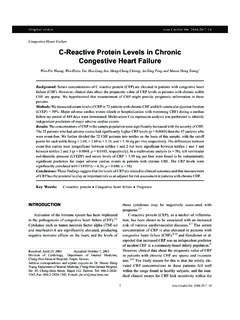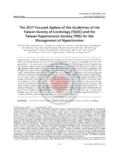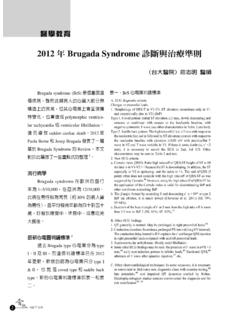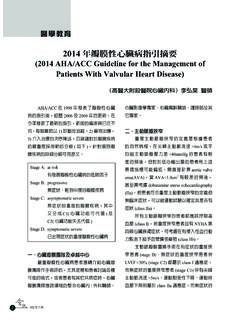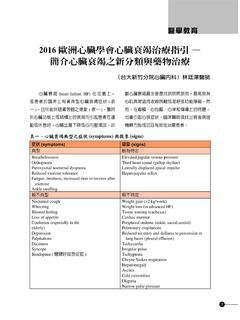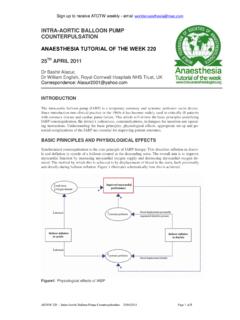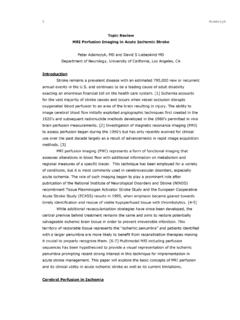Transcription of New Advances in the Diagnosis and Management of ...
1 New Advances in the Diagnosis andManagement of cardioembolic StrokeMei-Shu Lin,1 Nen-Chung Chang2and Tsung-Ming Lee3 cardioembolic stroke accounts for one-fifth of ischemic stroke and is severe and prone to early resonance imaging, transcranial Doppler, echocardiography, 24-hour electrocardiographic monitoringand electrophysiological study are tools for detecting cardioembolic sources. Non-valvular atrial fibrillation (AF) isthe most common cause of cardioembolic stroke and long-term anticoagulation is proved to prevent stroke. Despiteknowledge of guidelines, doctors recommend anticoagulant for less than half of patients with AF who have riskfactors for cardioembolic stroke and no contraindication for its usage.
2 Direct thrombin inhibitor offers the advantageof not needing prothrombin time controls and dose adjustments, but it needs large clinical trial for confirmation. Anytype of anticoagulant by any route should not be used in acute cardioembolic stroke. Stroke after percutaneouscoronary intervention (PCI), although rare, is associated with high mortality. Cardiologist must flush cathetersthoroughly, minimize catheter manipulation and use minimal contrast medium during Words:Stroke Heart Embolism Percutaneous coronary interventionINTRODUCTIONC ardioembolic stroke accounts for about 20% ofischemic ,2 cardioembolic strokes are severeand prone to early emboli maycause massive, superficial, single large striatocapsularor multiple infarcts in the middle cerebral artery.
3 Cer-tain clinical syndromes such as Wernicke s aphasia orglobal aphasia without hemiparesis are common incardioembolic stroke. In the posterior circulation,cardioembolism can produce Wallenberg s syndrome,cerebellar infarcts, basilar syndrome, multilevel in-farcts, or posterior cerebral artery infarct. Hemiparesisand lacunar infarct, especially multiple lacunar infarcts,are not likely cardioembolism- can be reliably predicted clinicallybut is hard to ,2 The features suggestive ofcardioembolic stroke are clinically decreased conscious-ness at onset,1,2rapid regression of symptoms,1,2suddenonset to maximal deficit < 5 min,1,2and visual field de-fects, neglect, or ,2 Simultaneous or sequentialstrokes in different arterial territories (combined anteriorand posterior, or bilateral, or multilevel posterior circula-tion)
4 And hemorrhagic transformation of an ischemicinfarct found on computed tomography (CT) or magneticresonance imaging (MRI) are all characteristic recanalization of occluded intracranial vessel, oc-clusion of the carotid artery by mobile thrombus, andmicroembolism in both middle cerebral arteries noted onultrasound or angiography indicate ,6 The clinical and imaging features suggestive of1 Acta Cardiol Sin 2005;21:1-12 Review ArticleActa Cardiol Sin 2005;21:1-12 Received: April 28, 2004 Accepted: August 11, 20041 Graduate Institute of Epidemiology, School of Public Health,National Taiwan University and Department of Pharmacy, NationalTaiwan University Hospital, Taipei,2 Division of Cardiology, Departmentof Internal Medicine, Taipei Medical University Hospital, Taipei,3 Department of Internal Medicine, College of Medicine, TaipeiMedical University and Division of Cardiology, Department ofInternal Medicine, Chi-Mei Medical Center, Tainan, correspondence and reprint requests to.
5 Nen-Chung Chang,MD, PhD, Division of Cardiology, Department of Internal Medicine,Taipei Medical University Hospital, Taipei, or Tsung-Ming Lee, MD,Division of Cardiology, Department of Internal Medicine, Chi-MeiMedical Center, Tainan, Taiwan. Tel: 886-2-2737-2181 ext. 3101;Fax: 886-2-2391-1200 or 886-2-2736-4222;E-mail: or are highly specific but less sensitivewith a positive predictive value below 50%.1,6 Only a few papers regarding cardioembolic stroke inTaiwan have been published. The National Taiwan Uni-versity Hospital Stroke Registry in 1995 described 676patients with cerebral infarction, 20% of which werecardioembolic stroke was the most com-mon type (29%).
6 The percentage and characteristic featuresof cardioembolic stroke in Taiwan were similar to those inwestern ,6,7 cardioembolic patients had a higherpercentage of atrial fibrillation (AF) (69%), cardiomegaly,and ischemic heart disease than non- cardioembolic pa-tients,which might account for a higher case-fatality ratethan other cerebral infarction patients. Interestingly, only3% of cardioembolic patients had carotid stenosis 50%.HOW TO IDENTIFY A CARDIOEMBOLICSTROKE?BrainMRI is more sensitive for the detection of car-dioembolic stroke than ,6 The sensitivity of MRI tohemorrhagic transformation is higher than that of ,6 Hemorrhagic transformation develops in up to 70% ofcardioembolic ,6 About 90% of hemorrhagictransformations are caused by cardiogenic brain ,6 There are two types of hemorrhagic trans-formation: multifocal, which is less symptomatic, andhematoma, which has mass effect and clinical deteriora-tion.
7 The mechanism of hemorrhagic transformation isreperfusion of ischemic zones, which occurs with spon-taneous resolution of the emboli. Arterial wall traumaand dissection at the site of the thrombus are conscious level, total circula-tion infarcts, severe strokes (National Institute of HealthStroke Scale score > 14), proximal occlusion, largehypodensity in more than 1/3 of the middle cerebral ar-tery territory, and delayed recanalization > 6 hours afteronsetpredict hemorrhagic transformation in ,6,9 Gradient-echo T2-weightedbrain MRI-shown old microbleeds are predictors of hem-orrhagic brain and heartA thrombus originating in the heart can occlude theinternal carotid artery.
8 Ultrasonography can detect suchemboli as oscillating, homogeneous, suspicion of cardioembolism increases ifangiography or transcranial Doppler shows that the ar-tery in the territory of the infarct is patent, or if there isearly recanalization of a previously occluded Doppler is helpful for the Diagnosis ofright-to-left shunting by detecting bubble signals( high-signal bubble sign ) passing the middle cerebralartery less than 20 seconds after agitated saline is in-jected in an antecubital Doppler canalso detect microembolic signals ( high-intensity tran-sient sign ) in the middle cerebral ,high-intensity transient signs are rarer in cardiac embo-lism than in carotid embolism.
9 They disappear a fewdays after the embolic event, and their relationship withthe cardioembolic risk or with the type of antithrombotictreatment is are three high-risk cardiac origins1,6,13forcardioembolic strokes: atrium, valve and ventricle. Atrialfibrillation (AF), atrial flutter, sick sinus syndrome, leftatrial thrombus, left atrial appendage thrombus and leftatrial myxoma are atrial origins. Mitral stenosis, prostheticvalve and endocarditis are valvular origins. Left ventricularthrombus, left ventricular myxoma, recent anterior myocar-dial infarct and dilated cardiomyopathy are ventricularorigins.
10 However, patent foramen ovale (PFO), atrial septalaneurysm (ASA), atrial spontaneous echo contrast, mitralannulus calcification, mitral valve prolapse, calcified aorticstenosis, akinetic/dyskinetic ventricular wall segment, hy-pertrophic obstructive cardiomyopathy and congestiveheart failure are low or uncertain risks. In many patientssuch as those with AF, sick sinus syndrome, rheumaticvalve and prosthetic valve disease, it is sufficient to makethe Diagnosis of a cardioembolic condition by history,physical examination, and electrocardiogram (ECG).1,6,13 Paroxysmal AF is an important cause of brain embolismthat is difficult to document.
